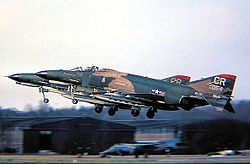Soesterberg military airfield
| Vliegbasis Soesterberg Camp New Amsterdam |
|
|---|---|

|
|
| Characteristics | |
| ICAO code | EHSB |
| IATA code | UTC |
| Coordinates | |
| Height above MSL | 20 m (66 ft ) |
| Transport links | |
| Distance from the city center | 14 km northeast of Utrecht |
| Street | 3 km to the A 28 |
| Basic data | |
| opening | 1910 |
| operator | Dutch Air Force |
| Start-and runway | |
| 09/27 | 3075 m × 45 m asphalt |
The Vliegbasis Soesterberg was a military airfield of the Koninklijke Luchtmacht (KLu), the Dutch air force . It was also used for decades by the United States Air Forces in Europe (USAFE), which they referred to as Soesterberg Air Base . The base is in the province of Utrecht at the southwestern tip of the Soest municipality , directly north of the eponymous town of Soesterberg . It was closed in 2008.
Part of the airfield is still used today as a glider airfield. The former barracks area of the USAFE is used today by the royal land power . Like the Americans at the time, they call the barracks Camp New Amsterdam .
history
The airfield in Soesterberg was established in 1910 as a privately operated airfield of Verwey & Lugard's Automobiel-Maatschappij . One of the first air shows in the Netherlands took place there on November 27, 1910. After the company went bankrupt, the airfield was taken over by the Dutch army in 1913. It was the first airfield for the Dutch military and was used for pilot training during the First World War .
After the German occupation of the Netherlands by the German Wehrmacht in May 1940, the base was from the Air Force developed and later in the Second World War as an air base used. The air force had various types of aircraft stationed in Soesterberg. They flew air raids against England and British convoys in the North Sea. Groups of Kampfgeschwader 4 (KG 4) and 40 (KG 40) used the base. The former received during the Battle of Britain , she flew the He 111H / P at the time, and was visited in October 1940 by the Commander-in-Chief of the Air Force Hermann Göring . The second group of the latter (II./KG 40) lay here between August 1941 and March 1943 and flew with their Do 217 air raids against British convoys in the North Sea.
The Do 217E / K of the staff of Kampfgeschwader 2 (KG 2) lay here from the end of 1941 to the beginning of 1944, groups of the same squadron were added at times. Towards the end of their stationing in Soesterberg, the bombers took part in the Steinbock operation. There were also fighters to fight the Allied bombing raids here. These caused more and more damage to the Soesterberg air base and in September 1944 its use had to be discontinued after increased bombing in connection with Operation Market Garden .
After the end of the war, the base was completely rebuilt by the Netherlands and was put into operation in August 1951 by the KLu, which initially used it as an air defense base. Later T-33 trainers were stationed here.
After the start of the Cold War , the US reinforced back its military presence in Europe and Soesterberg was from 1954 next to the Dutch Vliegbasis an American air base . US forces operated from an area of the site known as Camp New Amsterdam in honor of the first Dutch settlement in the New World, now New York (City) .
In November of that year , the 512th Fighter-Day Squadron from RAF Manston arrived in the Netherlands with their F-86F . This was renamed the 32d Fighter-Day Squadron 10 months later and subordinated to the 36th Squadron in Bitburg . The unit kept the number "32" until its dissolution in 1994, but the respective designations were changed several times. After the first conversion to the F-100 in 1956, another one to the F-102 A followed in 1959 , which in turn gave way to the F-4E in 1969 . These finally gave way to the F-15A / B in 1978 , which, however, were replaced by the more modern C / D variants after less than two years. The USAFE withdrew their F-15C / D in 1994 and the 32d Fighter Group , as it was called at the time, was dissolved as a fighter association.
The KLu continued to use its part of the airfield parallel to the USAFE. Between 1968 and 1992 the 334th Sqn. with 12 F-27-100 and 300M transporters and, from 1969, the 298th Sqn. with Alouette III helicopters.
The Dutch armed forces operated the base after deduction of USAFE one and a half decades as a helicopter base on alone before also ended for the Netherlands of the military operations of 2008. The 298th Sqn., Which had been converted to the CH-47D in 1995, and next to it from 1995 the Cougar Mk.2 were located here. the 300th season. This later also received the Alouette III. Both seasons were moved from here to Gilze Rijen .
Others
Two memorials were erected on the site, one for fallen aviators and one for 33 resistance fighters murdered by the Germans in a nearby wood .
The Museum of Dutch Military Aviation is also located in Soesterberg.
Web links
- English language homepage of the Dutch Military Aviation Museum
- Dutch website with a variety of historical photos
Individual evidence
- ^ Advertisement for Verwey & Lugard's Vliegkamp Soesterberg. In: De Eemlander, November 26, 1910, p. 3.
